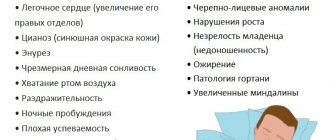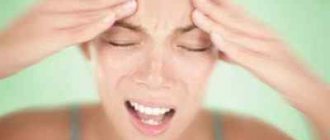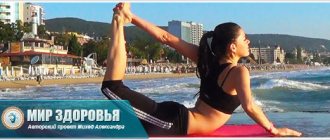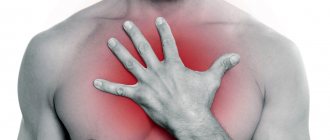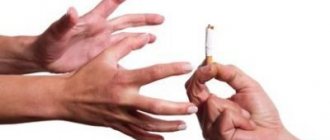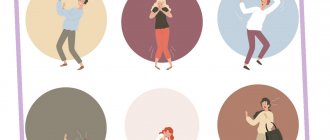Causes, manifestations of the disease and treatment features
There are several types of shortness of breath. The separation is caused by various pathologies that provoke breathing problems. Among the causes of shortness of breath are:
- Lung diseases. Lead to the development of pulmonary dyspnea.
- Heart diseases. Cardiac dyspnea develops. Disturbs both when walking and at rest.
- The appearance of harmful compounds in the blood. It can be caused by liver failure, diabetes mellitus, and poisoning.
- Anemia. A hemic type of breathing change develops.
- Disturbances occurring in the respiratory center of the central nervous system. May be associated with organic lesions, neuroses, and exposure to neurotropic toxic substances.
Regardless of the type of shortness of breath, it is characterized by similar symptoms. Manifestations of respiratory pathology include:
- the occurrence of a sudden lack of air (for example, when running);
- the appearance of whistling or wheezing when breathing;
- changes in the rhythm and depth of breathing;
- the appearance of pallor of the skin;
- blueness of lips.
Already when the first signs of shortness of breath appear, you should consult a doctor and begin treatment. Typically it includes the following areas:
- elimination of zones of infectious process in the respiratory system;
- restoration of the full functioning of the digestive, lymphatic systems, heart, blood vessels, psycho-emotional health (it is better not to take sedatives, they have many side effects);
- increasing the level of the body's defenses.
Diagnosis of respiratory neurosis
With all this “bouquet” of symptoms, the patient most often first sees a general practitioner. But the truth is that only a small number of doctors in clinics can suspect a mental disorder and advise you to see a specialist. Most often, therapists say that “this happens with VSD,” since vegetative-vascular dystonia is still considered in Russia a disease of blood vessels and nerves that has nothing to do with the psyche.
In fact, you need to see a psychiatrist or psychotherapist. But before that, real respiratory diseases must be ruled out. For this purpose the following studies are prescribed:
- General blood and urine analysis;
- Fluorography or x-ray of the lungs;
- Blood test for hormones.
If the tests do not reveal any real problems, the doctor concludes that the cause of the “breathing” attacks is neurotic, and should be treated by a psychiatrist or psychotherapist. Unfortunately, treating such disorders exclusively with folk remedies is, as a rule, completely ineffective, so in this case it is impossible to do without professional help.
The use of breathing exercises
Breathing exercises are an aerobic exercise. You can do it at any age, regardless of gender and physical shape. Thanks to regular use of breathing exercises:
- the correct movement of the diaphragm is carried out;
- gas exchange accelerates;
- blood flow to the myocardium improves;
- the functioning of the nervous system is restored;
- there is an increase in lung volume;
- the functioning of the heart and blood vessels improves; swelling of the limbs and face decreases.
Despite the large list of advantages, you should familiarize yourself with the contraindications before performing the exercises. These include the following points:
- pathologies of discs and cartilage located between the vertebrae;
- development of acute thrombophlebitis;
- presence of radiculitis;
- mental disorders;
- somatic diseases;
- head injuries;
- presence of severe spinal column injuries;
- the appearance of bleeding;
- sudden jumps in blood pressure;
- condition after a heart attack.
VSD and difficulty breathing. therapeutic exercises for VSD
An imbalance between parts of the autonomic nervous system leads to vegetative-vascular dystonia.
There are several types of VSD, they depend on how severe the disease is. Each type has its own complex treatment.
Heavy breathing occurs when the respiratory course of the disease develops. And if you do nothing, the symptoms become more intense.
How does the body perceive exercise?
Our body enjoys movement - unless, of course, it is excessive load. Breathing becomes deeper and more rhythmic, blood flow increases. This means that all our tissues and organs receive more oxygen and nutrients. The functioning of all organs and systems of the body, including the respiratory system, improves.
Even the character of a person who exercises regularly changes. He becomes more strong-willed, persistent, and self-confident. Agree, without all these qualities, any athlete would hardly continue training after several days of enthusiasm.
But even more interesting are the changes taking place in worldview. Together with the will to live, such a person develops internal balance. And this is the key to calmly perceiving any problems, and then solving them constructively.
Types of load
Some types of exercise are especially effective in combating the disease. In combination, they give a quick and lasting effect.
| Swimming |
|
| Jogging, or better yet, brisk walking |
|
| Classical or step aerobics |
|
| Bike |
|
| Morning exercises and contrast shower |
|
How to learn to breathe correctly during VSD
You can overcome shortness of breath that occurs with vascular dystonia by mastering proper breathing techniques.
To do this you need to follow these tips:
- Diaphragmatic breathing is carried out when not only the chest, but also the front wall of the abdomen takes part in inhalation. This process occurs as follows: the lungs expand, after which the chest expands. The last thing to do is raise the abdomen. Exhalation should involve the reverse order of these actions.
- Inhalation is carried out through the nose. This is very important because the air is not only purified by passing through the nostrils, but also moistened, becoming warmer. This helps to relax the respiratory system.
- Squats will help normalize breathing. While inhaling, the legs bend at the knees and the body lowers, and when straightening, you need to inhale.
Massage
Click to enlarge
Vegetative-vascular dystonia is usually not accompanied by structural organ disorders. Nevertheless, this syndrome causes a lot of unpleasant sensations. Experts offer several ways to combat it.
To alleviate the condition, the following are used: psychotherapy, acupuncture, physical therapy for VSD, swimming, massage and medications. Massage for VSD is a very effective treatment.
Recently, its popularity has increased greatly.
Features of massage for different types of dystonia
Autonomic dystonia is a painful condition that is accompanied by several symptoms. It is believed that it occurs due to a malfunction of the ANS, which regulates the activity of almost all organs and systems in the human body.
The autonomic nervous system is divided into sympathetic and parasympathetic. The first is responsible for metabolic processes: increased blood pressure, increased secretion from the endocrine glands, and so on. Thanks to the second, opposite processes are launched. An imbalance between them causes the syndrome.
When treating the syndrome with massage, it is imperative to take these differences into account. In the first version, the manipulations should give a relaxing effect, in the second, the massage should be quite intense, tonic and even warming.
When affecting muscles and skin, massage has a strong reflex effect on the entire body. The relaxing effect of this procedure should be noted, because anxiety and worry are the most common causes of exacerbation of VSD.
Due to the large number of symptoms, it is sometimes difficult for doctors to determine the type of VSD disorder. The patient may have intermittent high or low blood pressure, heart pain, or psychoemotional disorder. Due to this abundance of complaints, it is difficult to choose the right type of massage.
Sometimes, in order to eliminate negative consequences, a short session time is assigned or a limited number of manipulations are used.
General recommendations for performing massage for VSD
Since massage is often only one of several means of treating vegetative dystonia, it is necessary that its effect does not conflict with other purposes.
Some recommendations for massage:
- At first, therapeutic massage should be carried out in a gentle manner.
- You need to increase intensity no earlier than in the middle of the course.
- The strongest impact should be applied no earlier than in the middle of the session.
- You should not start using all types of treatment procedures together. We are talking about a combination of medications, exercise therapy, massage and physiotherapy.
Types of massage
To treat VSD of the hypertensive type, classic massage of the pelvic area, back, abdomen and legs is most often used. Intense exposure increases vascular tone, improves blood supply to internal organs, and normalizes the functioning of the nervous system. With this type of treatment, 10 to 20 sessions are necessary.
This type of massage is not very common in our country. The massage therapist affects active points, as a result of which the body’s condition improves.
The effectiveness of self-massage is not as great as sessions with a specialist. However, it also has a positive effect on well-being and this method is always available to the patient. This type of massage is best done in the morning, but these exercises can be used at any time of the day if the condition worsens.
Self-massage is carried out by pressing with circular movements of the palm in the area of the crown, rubbing with fingers behind the ears, pressing and rubbing the temples, and other manipulations. Its total duration is approximately 5 minutes. A greater effect can be achieved if you do it in the shower or bath.
You should take a contrast shower during VSD as often as possible, as it has a healing effect.
Source: https://stopzaraza.com/serdce/dyxanie-pri-vsd-gimnastika-po-strelnikovoj-butejko.html
Simple exercises
There are various exercises included in the breathing exercises complex. Among the simplest are the following:
Exercise 1. Can be performed in any position, even during a regular walk in the park. Exhale through your mouth, then inhale through your nose. After this, exhale air through your mouth, draw in your stomach and count to 10. After this, inhale through your mouth so that the air flows into the stomach. Then draw it in and do not breathe, while counting to 10.
Exercise 2. To perform it, you should stand or sit down. Your arms should be bent at the elbows. It is necessary to open your palms so that they are visible. The essence of the exercise is a combination of clenching your fists and taking short breaths. 8 repetitions are required. After this, the hands are lowered for a few seconds (5 - 10). Then the exercise is repeated. It is permissible to perform up to 20 approaches.
Exercise 3. Will help relax the shoulder and neck muscles, which are considered additional muscles of breathing. You need to sit comfortably, spread your legs freely, and relax your arms. You should raise your shoulders up and tense your muscles as much as possible. This is followed by relaxation and a short rest. Number of repetitions - up to 10.
Exercise 4. Aimed at strengthening the abdominal muscles. You need to lie down, bend your knees, and press your feet to the floor. As you exhale, tense your abdominal muscles and raise your pelvis until your back touches the floor. After this, return to the starting position.
Shortness of breath, caused by various diseases, can cause discomfort both when walking and at rest. The use of breathing exercises and proper exercises will reduce the discomfort experienced. We should not forget about other methods of restoring full health. Daily exercise, conditioning the body, proper nutrition - these activities will help restore health and feel better.
Treatment of respiratory neurosis
Therapy for any neurosis must be comprehensive. And it should be based on the patient’s desire to return to normal life, without seizures and restrictions. Often, patients have so-called “secondary benefits” from their condition - for example, the opportunity not to work or to send a child to their grandmother so as not to “disturb the sick mother.” In this case, motivation will be significantly reduced, and treatment will be ineffective.
How to treat respiratory neurosis? Complex therapy for all neurosis-like disorders includes medication support, sessions with a psychotherapist, as well as lifestyle changes, giving up bad habits, normalizing work and rest patterns, as well as nutrition. And if everything is more or less clear with the regime and habits, then it’s worth talking about other aspects in more detail.
Drug treatment
Typically, psychiatrists for such conditions prescribe antidepressants and anti-anxiety drugs (tranquilizers). You should not be afraid of these medications: modern medications for the treatment of depression and anxiety disorders, although they have a number of side effects (which not all patients have), are not addictive and help quickly enough. Within 1-2 weeks, the symptoms of respiratory neurosis will become less pronounced, and in the future they may disappear completely.
Never try to “prescribe” yourself tranquilizers or antidepressants! Even the initial dose is selected individually for each patient, and specialist supervision is necessary throughout the treatment. Also, you should not stop taking the drug at your own request, as this can cause withdrawal symptoms and an increase in all negative symptoms, which will lead to an even deeper depression.
Another interesting and important point is that sedatives that can be freely purchased at pharmacies (Afobazol, Tenoten, Novopassit and others) are not used in the treatment of neuroses, since their effect is too weak. Therefore, you should not waste money and effort - trust your doctor, who will select the necessary medications.
It is worth noting that antidepressants are extremely rarely prescribed during pregnancy, so expectant mothers will have to select more gentle methods and medications.
Psychotherapy
It is the main method of treating neuroses, since these disorders arise, among other things, due to the peculiarities of the patient’s worldview. For example, some people inflate even a minor incident into a huge problem (“catastrophizing”), because of one ordinary mistake at work they tend to consider themselves completely worthless specialists, etc. The constant fear of error causes chronic anxiety, and over time it begins to manifest itself in bodily symptoms.
Sometimes neuroses arise due to serious shocks. For example, if a person was drowning but was able to escape, his subconscious “remembers” the feeling of suffocation, and at the slightest stress an attack of difficulty breathing occurs. Such psychological traumas can also be worked through in therapy to remove the unpleasant symptom.
The most progressive method of treating neuroses is cognitive behavioral therapy. It only takes about 20 sessions to get a noticeable effect. In general, the duration of therapy depends on the severity of the disorder and the patient’s willingness to work with a psychotherapist.
If we are talking about a small patient, then not only he himself will need psychotherapy, but also his parents. Often, respiratory neurosis appears in children as a result of a difficult atmosphere at home and conflicts between relatives. Therefore, before treating a child, it is necessary to create a more comfortable atmosphere in the family - otherwise other methods may be useless.
Treatment of neuroses at home
Despite the fact that neurotic disorders cannot be cured entirely with folk remedies alone, treatment at home is still possible, but it will be “supportive” rather than basic.
The patient must carefully and every day take the medications prescribed by the doctor. It is also worth giving up bad habits, starting to lead a healthier lifestyle, and increasing physical activity.
Another effective means of treating breathing disorders in neuroses is breathing exercises. However, it will be useful for any neurotic disorder, as it helps to calm down, relax, and stop obsessing over disturbing thoughts.
Breathing exercises should be done regularly, preferably every day. If the patient is at home during an attack of difficulty breathing, you can try to relieve the spasm of the respiratory muscles with the help of exercises. We recommend watching a video about breathing exercises.
Breathing exercises for the treatment of neurotic diseases. A simple complex, ideal for daily activities.
Rules
Basic rules for performing breathing exercises. Any tasks, including breathing ones, require attention from a doctor. Thoughtless independent performance of breathing exercises can be fraught with complications and negative effects if the tasks are performed incorrectly. There are a number of rules that help to positively influence the state of the body:
- The exercises should be performed under the strict supervision of a specialist. This will allow you to correctly rationalize and dose the load in order to determine the optimal level of exercise necessary for a person’s speedy recovery and prevent the risk of complications.
- Breathing exercises for bedridden patients should be as simple as possible to perform, while affecting the largest number of muscles.
- It is necessary to show the victim the correct technique for carrying out the task in order for him to perform the exercises correctly.
- When performing tasks, you should not overstrain your chest muscles.
- All breathing exercises are performed slowly and smoothly.
- Gymnastics for bedridden patients should be carried out for a short time; deep breathing movements should not be performed for a long time - this may make the patient dizzy, and there is a risk of worsening the condition.
- The gymnastic exercise routine should be stopped as soon as the victim becomes tired or his condition worsens.
- All physical techniques should be performed in comfortable, non-constrictive clothing for the patient.
Walking is a happiness that many people don't realize
These rules create optimal conditions for the victim and promote the correct technique for performing the task. In addition, the implementation of simple rules helps reduce the risk of complications and deterioration of the condition.
Today, there are a large number of methods of performing gymnastics for bedridden patients. The most common Strelnikova method. Strelnikova’s gymnastics is not a panacea, you don’t need to get too carried away with it, but it has a rational grain. This method can be used as an additional method, combined with physical exercise.
Symptoms of respiratory neurosis
Most manifestations of hyperventilation syndrome are caused by a sharp decrease in the concentration of carbon dioxide in the blood. However, for their occurrence, a number of conditions are necessary, in particular, high reactivity of the body and its sensitivity to fluctuations in blood composition.
The main feature of respiratory neurosis is characteristic attacks. During an attack, breathing is shallow, rapid, turning into a short-term cessation of breathing, followed by several convulsive deep breaths. The attack is accompanied by a feeling of fear for one’s life and.
Symptoms of respiratory neurosis are not always limited to respiratory ones. They can be divided by target organs:
- From the respiratory system, the symptoms are the most striking: severe shortness of breath, obsessive sighs and yawning, and a constant dry cough.
- The cardiovascular system reacts with disturbances in heart rhythm, pathological acceleration, and various types of heart pain.
- On the part of the digestive system, both banal complaints can be observed - abdominal pain, constipation, loss of appetite, as well as more rare ones - difficulty swallowing food, belching of air, unavoidable dry mouth.
- Disorders of the musculoskeletal system are manifested by tremors and muscle pain.
- The nervous system can react with unpleasant sensations in the limbs, a feeling of “crawling goosebumps,” dizziness, and fainting.
- Of the purely mental symptoms, they most often occur during an exacerbation. During periods of improvement, anxiety and restlessness persist.
- Of course, respiratory neurosis is also accompanied by general disturbances in the functioning of the body, such as fever, weakness, deterioration in working ability, and rapid onset of fatigue.
The above symptoms occur with varying frequencies. The most characteristic symptoms of respiratory neurosis are shortness of breath, chest pain and psycho-emotional disorders. Their combination makes it possible to suggest hyperventilation syndrome with a high degree of probability.

